Composite Proton Exchange Membranes Based on Chitosan and Phosphotungstic Acid Immobilized One-Dimensional Attapulgite for Direct Methanol Fuel Cells
Abstract
1. Introduction
2. Materials and Methods
2.1. Materials
2.2. Synthesis of Phosphotungstic Acid Immobilized Attapulgite
2.3. Preparation of CS-Based Composite Membranes
2.4. Characterization
2.5. DMFC Performance and Methanol Crossover Test
3. Results and Discussion
3.1. Synthesis and Characterization of WQAT
3.2. Characterization of Pure CS and CS/WQAT Composite Membranes
3.2.1. Structure and Morphology
3.2.2. Thermal and Mechanical Properties of the Composite Membranes
3.2.3. Water Uptake and Area Swelling of the Membranes
3.2.4. Proton Conductivity, Methanol Permeability and Single Cell Performance
4. Conclusions
Funding
Conflicts of Interest
References
- Munjewar, S.S.; Thombre, S.B.; Mallick, R.K. Approaches to overcome the barrier issues of passive direct methanol fuel cell-Review. Renew. Sustain. Energy Rev. 2017, 67, 1087–1104. [Google Scholar] [CrossRef]
- Mehmood, A.; Scibioh, M.A.; Prabhuram, J.; An, M.; Ha, H.Y. A review on durability issues and restoration techniques in long-term operations of direct methanol fuel cells. J. Power Sources 2015, 297, 224–241. [Google Scholar] [CrossRef]
- Mallick, R.K.; Thombre, S.B.; Shrivastava, N.K. A critical review of the current collector for passive direct methanol fuel cells. J. Power Sources 2015, 285, 510–529. [Google Scholar] [CrossRef]
- Radenahmad, N.; Afif, A.; Petra, P.I.; Rahman, S.M.H.; Eriksson, S.G.; Azad, A.K. Proton conducting electrolytes for direct methanol and direct urea fuel cells-a state-of-the-art review. Renew. Sustain. Energy Rev. 2016, 57, 1347–1358. [Google Scholar] [CrossRef]
- Zakaria, Z.; Kamarudin, S.K.; Timmiati, S.N. Membranes for direct ethanol fuel cells: An overview. Appl. Energy 2016, 163, 334–342. [Google Scholar] [CrossRef]
- Ran, J.; Wu, L.; He, Y.; Yang, Z.; Wang, Y.; Jiang, C.; Ge, L.; Bakangura, E.; Xu, T. Ion exchange membranes: New developments and applications. J. Membr. Sci. 2017, 522, 267–291. [Google Scholar] [CrossRef]
- Zakil, F.A.; Kamarudin, S.K.; Basri, S. Modified Nafion membranes for direct alcohol fuel cells: An overview. Renew. Sustain. Energy Rev. 2016, 65, 841–852. [Google Scholar] [CrossRef]
- Ma, J.; Sahai, Y. Chitosan biopolymer for fuel cell applications. Carbohydr. Polym. 2013, 92, 955–975. [Google Scholar] [CrossRef]
- Shaari, N.; Kamarudin, S.K. Chitosan and alginate types of bio-membrane in fuel cell application: An overview. J. Power Sources 2015, 289, 71–80. [Google Scholar] [CrossRef]
- Mukoma, P.; Jooste, B.R.; Vosloo, H.C.M. A comparison of methanol permeability in Chitosan and Nafion 117 membranes at high to medium methanol concentrations. J. Membr. Sci. 2004, 243, 293–299. [Google Scholar] [CrossRef]
- Xiang, Y.; Yang, M.; Guo, Z.; Cui, Z. Alternatively chitosan sulfate blending membrane as methanol-blocking polymer electrolyte membrane for direct methanol fuel cell. J. Membr. Sci. 2009, 337, 318–323. [Google Scholar] [CrossRef]
- Vijayalekshmi, V.; Khastgir, D. Eco-friendly methanesulfonic acid and sodium salt of dodecylbenzene sulfonic acid doped cross-linked chitosan based green polymer electrolyte membranes for fuel cell applications. J. Membr. Sci. 2017, 523, 45–59. [Google Scholar] [CrossRef]
- Yang, J.M.; Chiu, H.C. Preparation and characterization of polyvinyl alcohol/chitosan blended membrane for alkaline direct methanol fuel cells. J. Membr. Sci. 2012, 419–420, 65–71. [Google Scholar]
- Liu, H.; Gong, C.; Wang, J.; Liu, X.; Liu, H.; Cheng, F.; Wang, G.; Zheng, G.; Qin, C.; Wen, S. Chitosan/silica coated carbon nanotubes composite proton exchange membranes for fuel cell applications. Carbohyd. Polym. 2016, 136, 1379–1385. [Google Scholar] [CrossRef]
- Ou, Y.; Tsen, W.C.; Jang, S.C.; Chuang, F.S.; Wang, J.; Liu, H.; Wen, S.; Gong, C. Novel composite polymer electrolyte membrane using solid superacidic sulfated zirconia-functionalized carbon nanotube modified chitosan. Electrochim. Acta 2018, 264, 251–259. [Google Scholar] [CrossRef]
- Ou, Y.; Tsen, W.C.; Gong, C.; Wang, J.; Liu, H.; Zheng, G.; Qin, C.; Wen, S. Chitosan-based composite membranes containing chitosan-coated carbon nanotubes for polymer electrolyte membranes. Polym. Adv. Technol. 2018, 29, 612–622. [Google Scholar] [CrossRef]
- Phompan, W.; Hansupalak, N. Improvement of proton-exchange membrane fuel cell performance using platinum-loaded carbon black entrapped in crosslinked chitosan. J. Power Sources 2011, 196, 147–152. [Google Scholar] [CrossRef]
- Wu, H.; Hou, W.; Wang, J.; Xiao, L.; Jiang, Z. Preparation and properties of hybrid direct methanol fuel cell membranes by embedding organophosphorylated titania submicrospheres into a chitosan polymer matrix. J. Power Sources 2010, 195, 4104–4113. [Google Scholar] [CrossRef]
- Tsen, W.C.; Chuang, F.S.; Jang, S.C.; Kuo, T.W. Chitosan/CaCO3 solvent-free nanofluid composite membranes for direct methanol fuel cells. Polym. Eng. Sci. 2019, 59, 2128–2135. [Google Scholar] [CrossRef]
- Shi, B.; Li, Y.; Zhang, H.; Wu, W.; Ding, R.; Dang, J.; Wang, J. Tuning the performance of anion exchange membranes by embedding multifunctional nanotubes into a polymer matrix. J. Membr. Sci. 2016, 498, 242–253. [Google Scholar] [CrossRef]
- Bai, H.; Zhang, H.; He, Y.; Liu, J.; Zhang, B.; Wang, J. Enhanced proton conduction of chitosan membrane enabled by halloysite nanotubes bearing sulfonate polyelectrolyte brushes. J. Membr. Sci. 2014, 454, 220–232. [Google Scholar] [CrossRef]
- Gong, C.; Zhao, S.; Tsen, W.C.; Hu, F.; Zhong, F.; Zhang, B.; Liu, H.; Zheng, G.; Qin, C.; Wen, S. Hierarchical layered double hydroxide coated carbon nanotube modifed quaternized chitosan/polyvinyl alcohol for alkaline direct methanol fuel cells. J. Power Sources 2019, 441, 227176. [Google Scholar] [CrossRef]
- Nicotera, I.; Simari, C.; Coppola, L.; Zygouri, P.; Gournis, D.; Brutti, S.; Minuto, F.D.; Arico, A.S.; Sebastian, D.; Baglio, V. Sulfonated graphene oxide platelets in nafion nanocompositemembrane: Advantages for application in direct methanol fuel cells. J. Phys. Chem. C 2014, 118, 24357–24368. [Google Scholar] [CrossRef]
- Simari, C.; Enotiadis, A.; Vecchio, C.L.; Baglio, V.; Coppola, L.; Nicotera, I. Advances in hybrid composite membranes engineering for high-performance direct methanol fuel cells by alignment of 2D nanostructures and a dual-layer approach. J. Membr. Sci. 2020, 599, 117858. [Google Scholar] [CrossRef]
- Rambabu, G.; Bhat, S.D.; Figueiredo, F.M.L. Carbon nanocomposite membrane electrolytes for direct methanol fuel cells-A concise review. Nanomaterials 2019, 9, 1292. [Google Scholar] [CrossRef] [PubMed]
- Gong, C.; Zheng, X.; Liu, H.; Wang, G.; Cheng, F.; Zheng, G.; Wen, S.; Law, W.C.; Tsui, C.P.; Tang, C.Y. A new strategy for designing high-performance sulfonated poly (ether ether ketone) polymer electrolyte membranes using inorganic proton conductor-functionalized carbon nanotubes. J. Power Sources 2016, 325, 453–464. [Google Scholar] [CrossRef]
- Gong, C.; Xue, Z.; Wen, S.; Ye, Y.; Xie, X. Advanced carbon materials/olivine LiFePO4 composites cathode for lithium ion batteries. J. Power Sources 2016, 318, 93–112. [Google Scholar] [CrossRef]
- Liu, H.; Wang, J.; Wen, S.; Gong, C.; Cheng, F.; Wang, G.; Zheng, G.; Qin, C. Composite membranes of chitosan and titania-coated carbon nanotubes as promising materials for new proton-exchange membranes. J. Appl. Polym. Sci. 2016, 133, 43365–43371. [Google Scholar] [CrossRef]
- Gong, C.; Liu, H.; Zhang, B.; Wang, G.; Cheng, F.; Zheng, G.; Wen, S.; Xue, Z.; Xie, X. High level of solid superacid coated poly (vinylidene fluoride) electrospun nanofiber composite polymer electrolyte membranes. J. Membr. Sci. 2017, 535, 113–121. [Google Scholar] [CrossRef]
- Lai, S.Q.; Yue, L.; Li, T.S. An investigation of friction and wear behaviors of polyimide/attapulgite hybrid materials. Macromol. Mater. Eng. 2005, 290, 195–201. [Google Scholar] [CrossRef]
- Wang, W.; Li, A.N.; Zhang, J.; Wang, A. Study on superabsorbent composite. XI. Effect of thermal treatment and acid activation of attapulgite on water absorbency of poly (acrylic acid)/attapulgite superabsorbent composite. Polym. Compos. 2010, 28, 397–404. [Google Scholar] [CrossRef]
- Zhang, L.; Jin, Q.; Shan, L.; Liu, Y.; Wang, X.; Huang, J. H3PW12O40 immobilized on silylated palygorskite and catalytic activity in esterification reactions. Appl. Clay. Sci. 2010, 47, 229–234. [Google Scholar] [CrossRef]
- Wen, S.; Gong, C.; Shu, Y.C.; Tsai, F.C.; Yeh, J.T. Sulfonated poly (ether sulfone)/phosphotungstic acid/attapulgite composite membranes for direct methanol fuel cells. J. Appl. Polym. Sci. 2012, 123, 646–656. [Google Scholar] [CrossRef]
- Liu, G.; Tsen, W.C.; Jang, S.C.; Hu, F.; Zhong, F.; Liu, H.; Wang, G.; Wen, S.; Zheng, G.; Gong, C. Mechanically robust and highly methanol-resistant sulfonated poly (ether ether ketone)/poly (vinylidene fluoride) nanofiber composite membranes for direct methanol fuel cells. J. Membr. Sci. 2019, 591, 117321. [Google Scholar] [CrossRef]
- Choi, S.W.; Fu, Y.-Z.; Ahn, Y.R.; Jo, S.M.; Manthiram, A. Nafion-impregnated electrospun polyvinylidene fluoride composite membranes for direct methanol fuel cells. J. Power Sources 2008, 180, 167–171. [Google Scholar] [CrossRef]
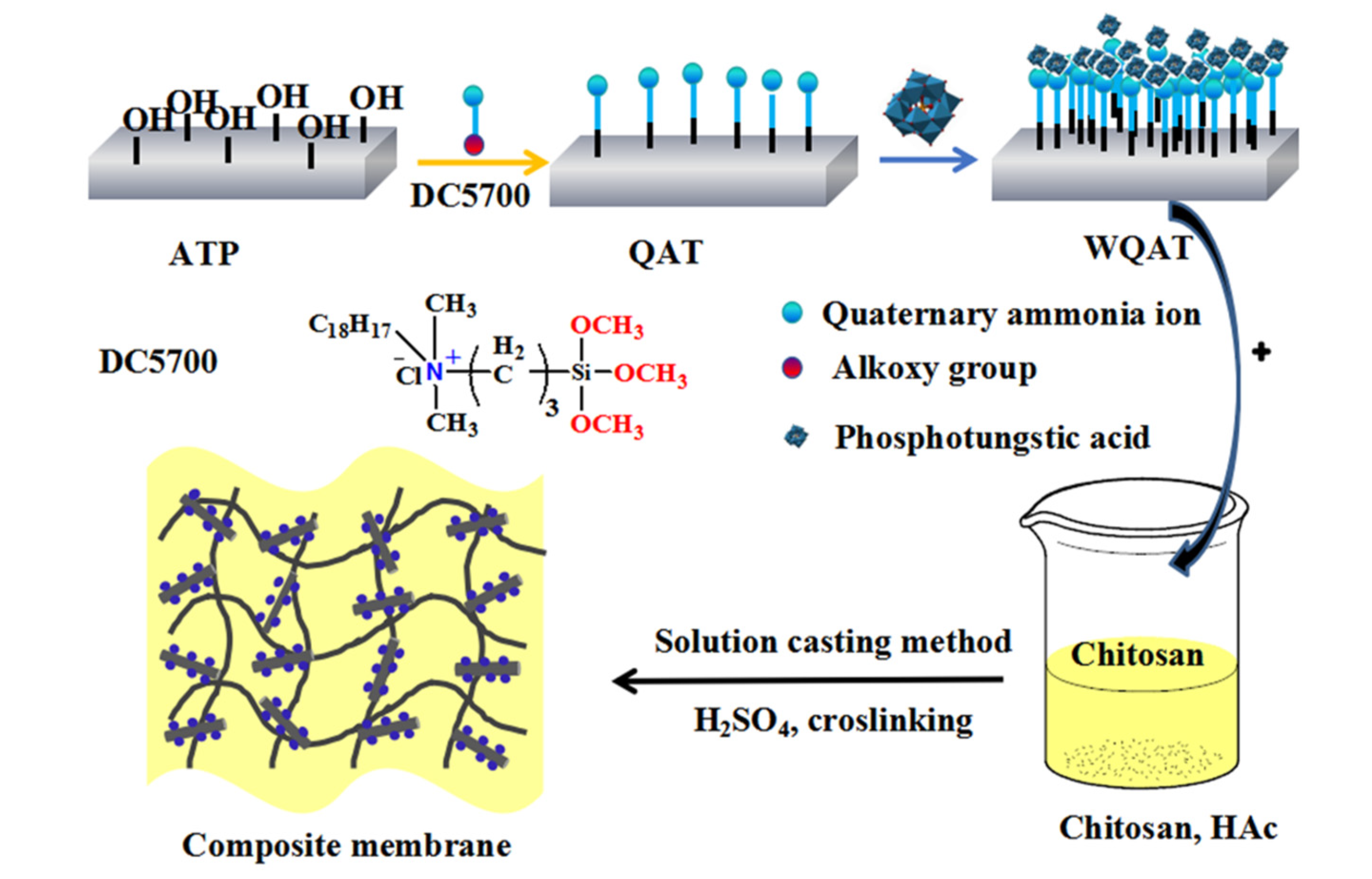
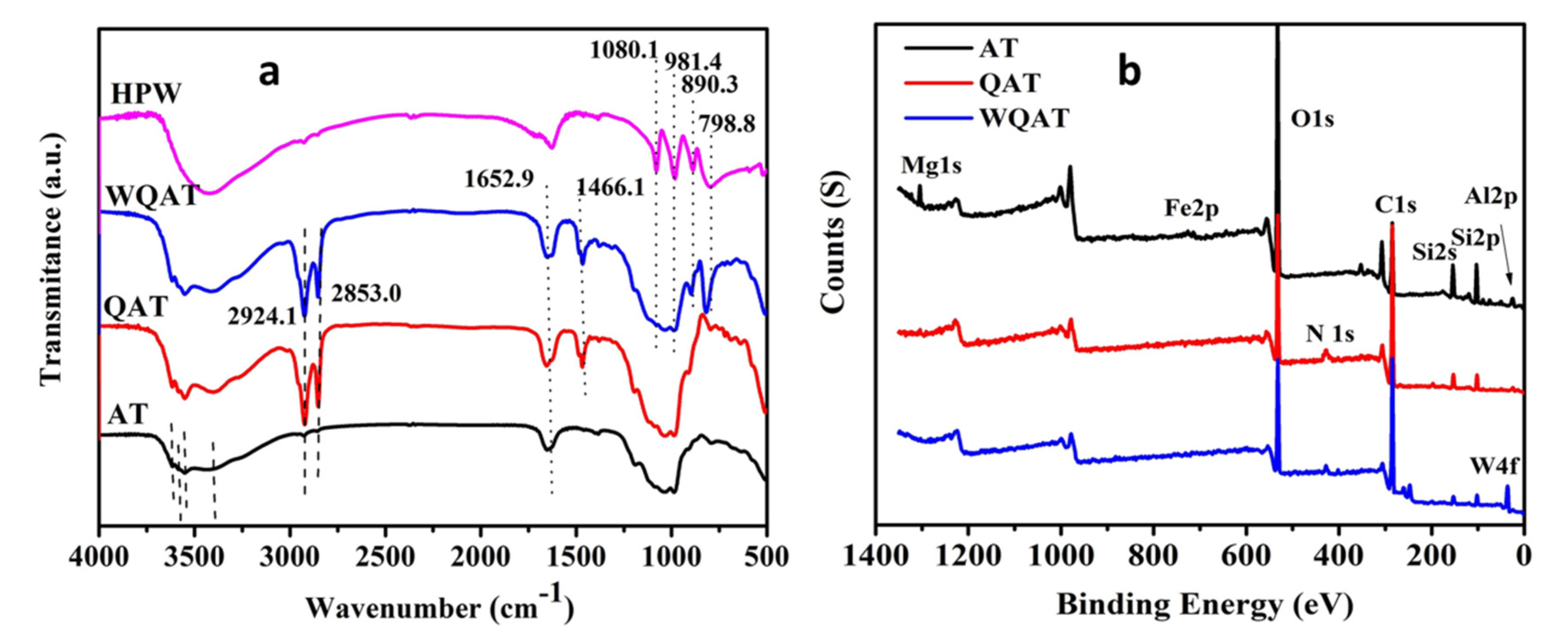
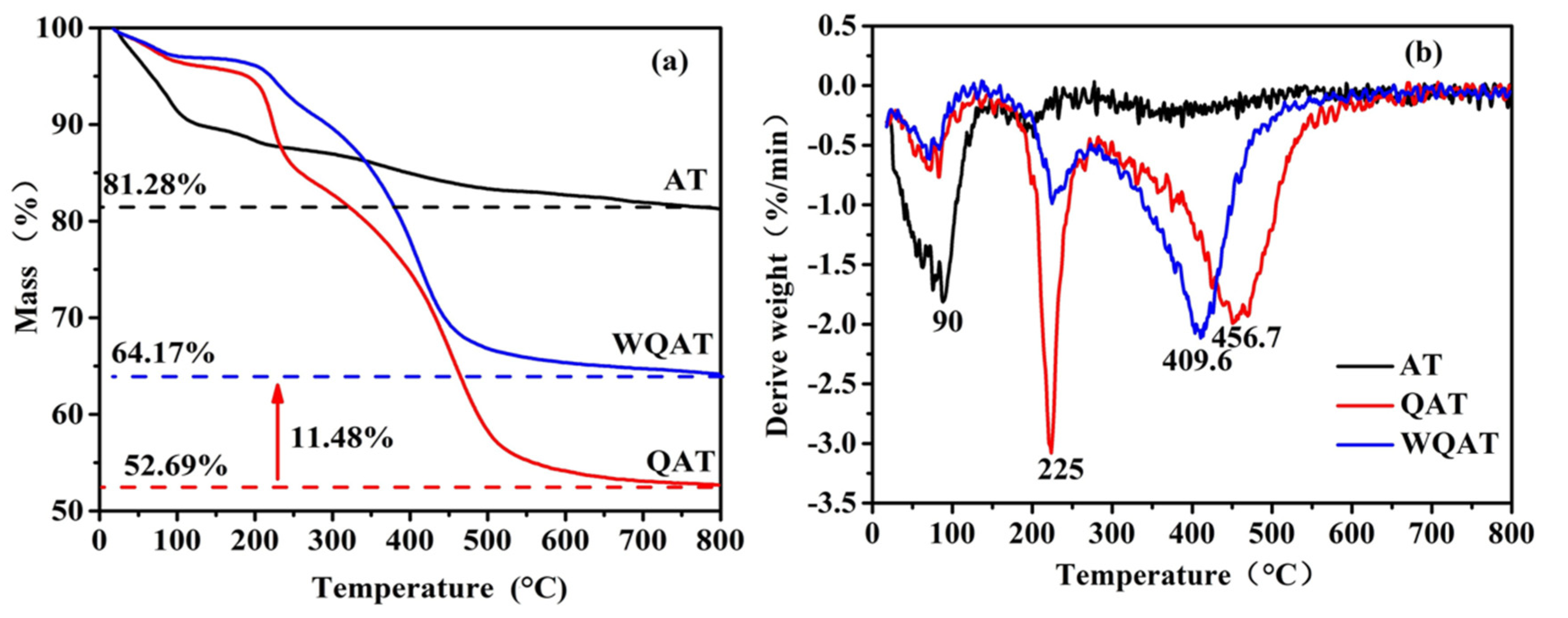
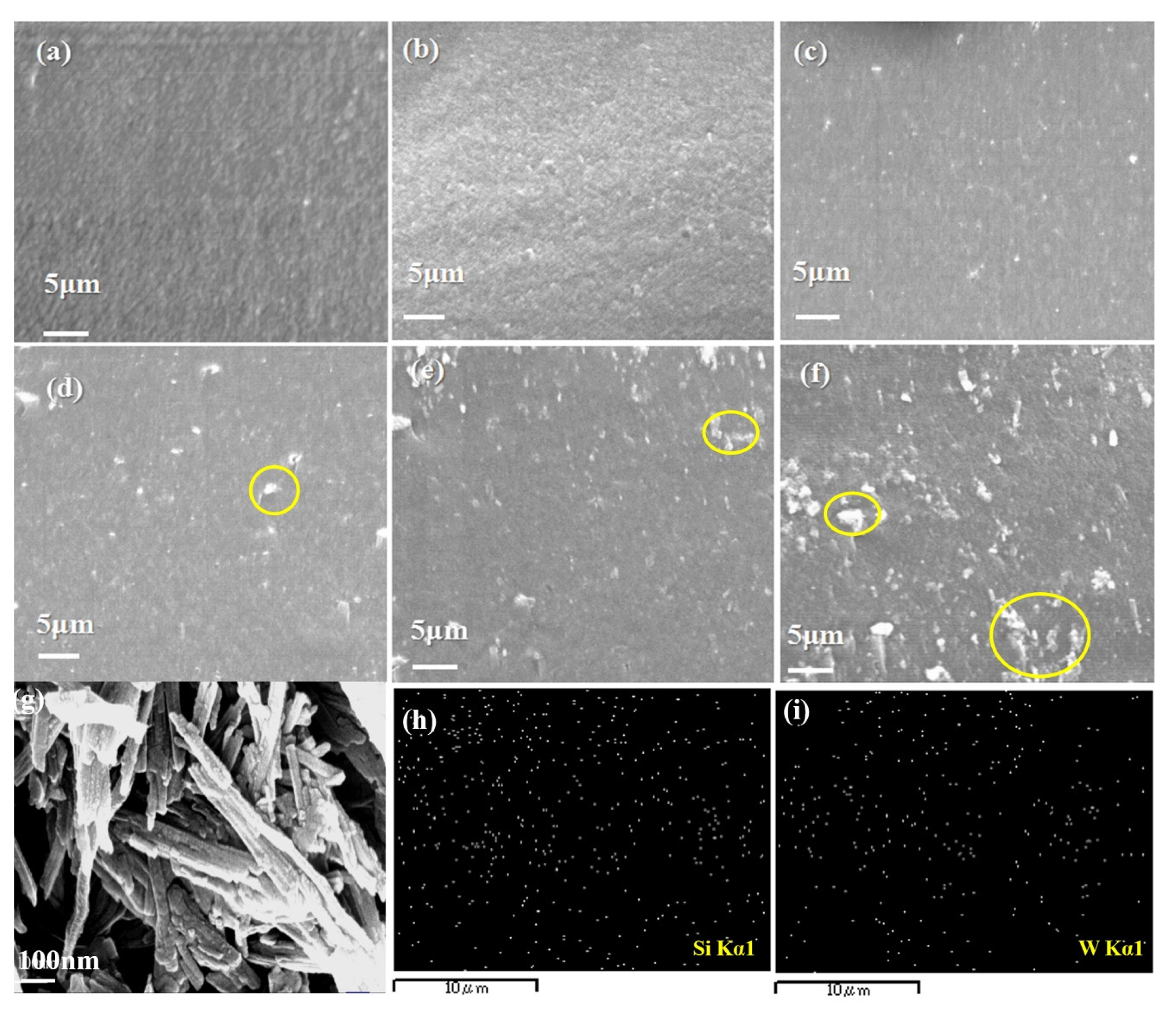
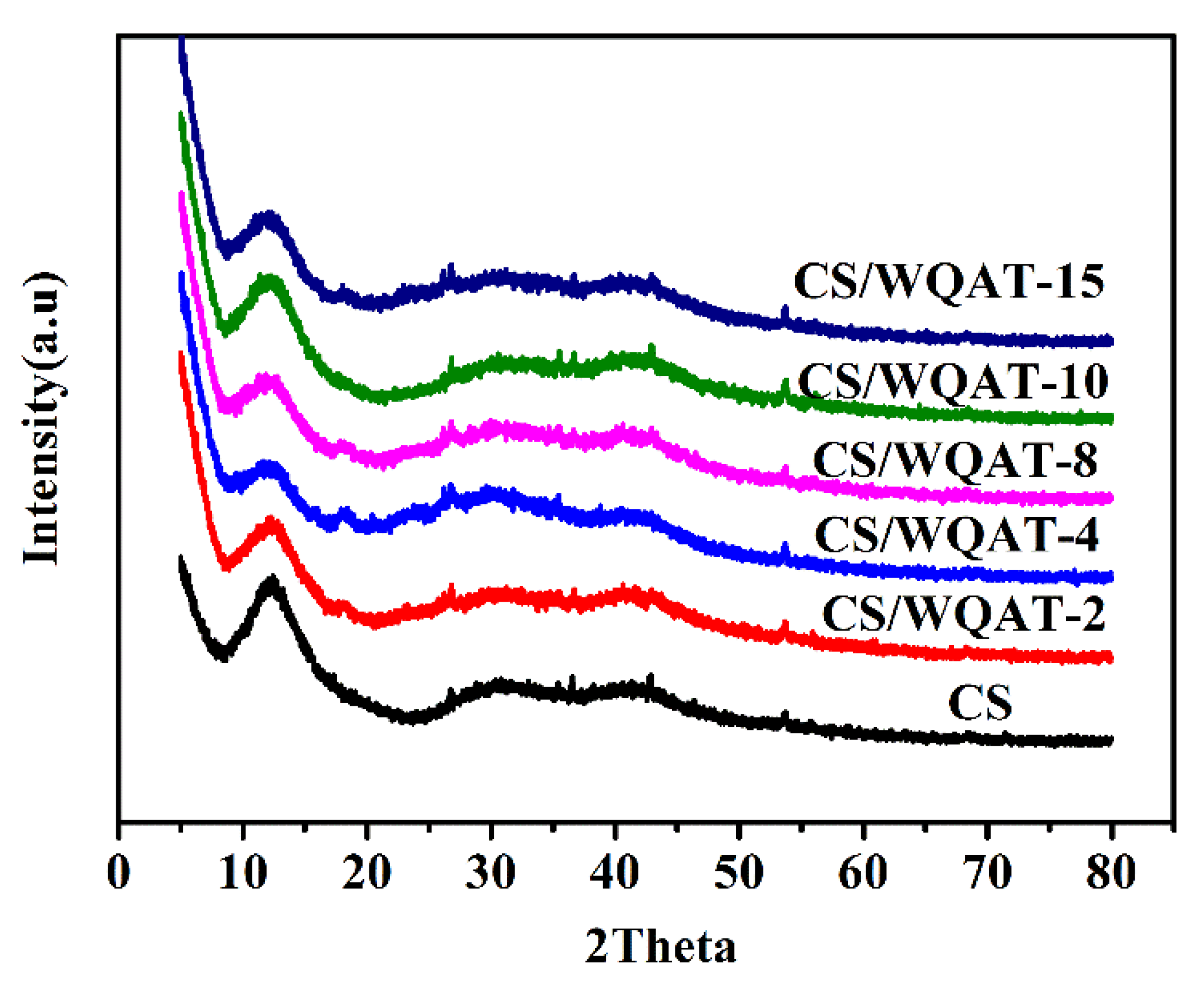
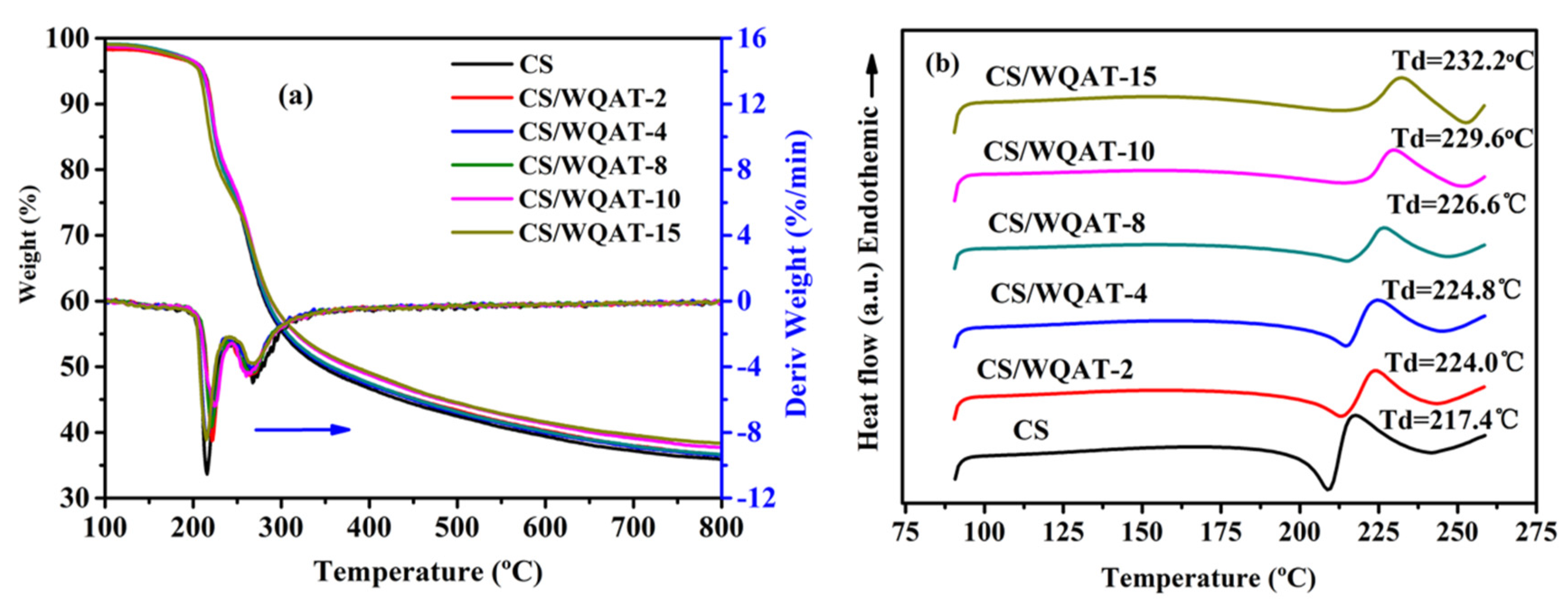
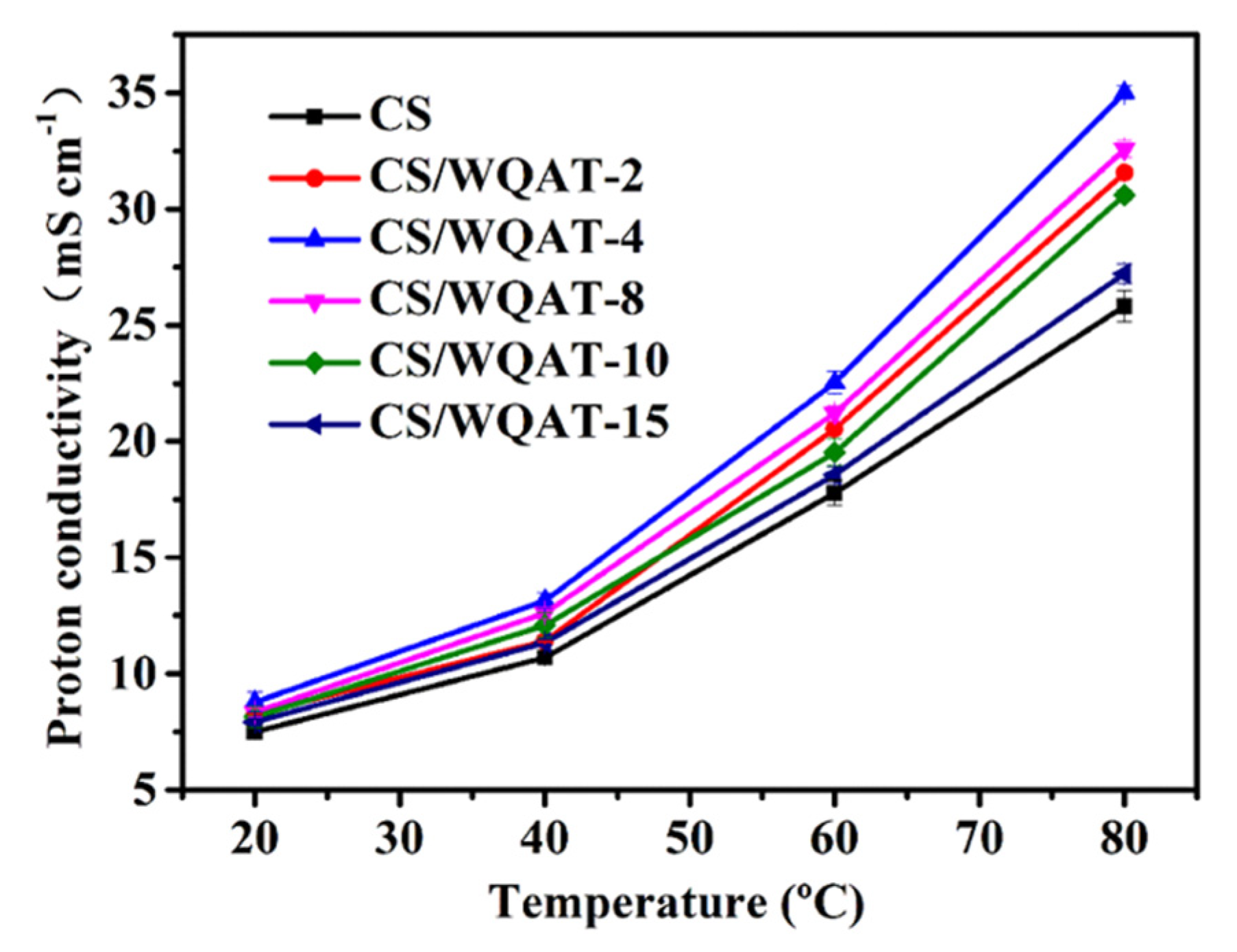
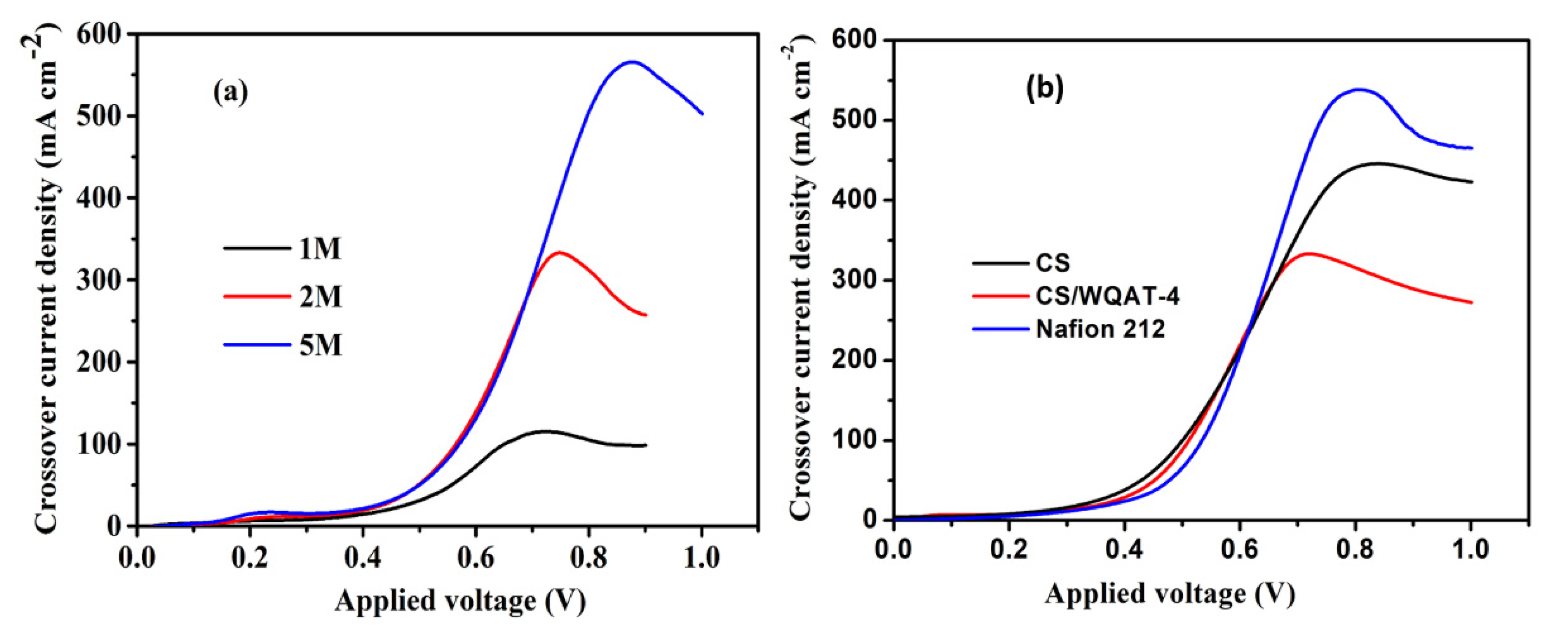
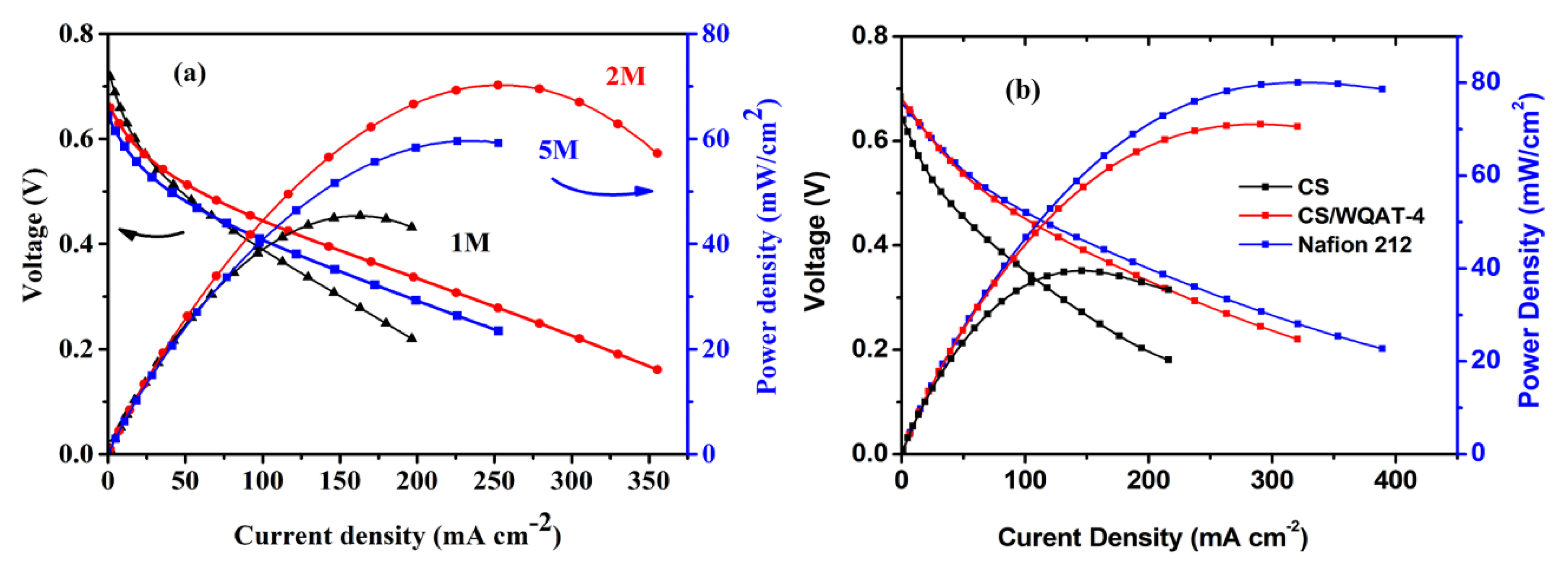
| Sample | Tensile Strength (MPa) | Elongation (%) | Young’s Modulus (MPa) |
|---|---|---|---|
| CS | 41.31 ± 2.0 | 17.07 ± 4.8 | 618.90 ± 10 |
| CS/WQAT-2 | 50.14 ± 2.7 | 20.89 ± 3.1 | 990.48 ± 11 |
| CS/WQAT-4 | 58.65 ± 2.5 | 23.21 ± 1.8 | 1152.69 ± 14 |
| CS/WQAT-8 | 52.37 ± 2.2 | 19.96 ± 2.5 | 980.78 ± 16 |
| CS/WQAT-10 | 48.67 ± 1.8 | 18.36 ± 4.5 | 890.54 ± 12 |
| CS/WQAT-15 | 42.8 ± 3.8 | 16.36 ± 2.4 | 720.54 ± 14 |
| Sample | 20 °C | 40 °C | 60 °C | 80 °C |
|---|---|---|---|---|
| CS | 68.15 ± 5.24 | 72.03 ± 6.52 | 88.05 ± 7.38 | 114.11 ± 7.7 |
| CS/WQAT-2 | 71.21 ± 3.37 | 74.00 ± 5.61 | 90.11 ± 4.28 | 121.17 ± 8.5 |
| CS/WQAT-4 | 72.09 ± 3.58 | 74.76 ± 4.53 | 92.69 ± 3.52 | 161.08 ± 7.3 |
| CS/WQAT-8 | 70.05 ± 4.12 | 74.86 ± 5.72 | 86.21 ± 6.92 | 150.93 ± 5.7 |
| CS/WQAT-10 | 68.44 ± 4.87 | 75.86 ± 3.57 | 89.27 ± 5.47 | 137.78 ± 8.3 |
| CS/WQAT-15 | 65.49 ± 3.73 | 75.98 ± 4.38 | 85.87 ± 3.39 | 123.64 ± 9.5 |
| Sample | 20 °C | 40 °C | 60 °C | 80 °C |
|---|---|---|---|---|
| CS | 5.17 ± 4.57 | 9.50 ± 4.36 | 17.81 ± 2.52 | 38.02 ± 5.33 |
| CS/WQAT-2 | 5.16 ± 3.97 | 9.32 ± 4.38 | 15.64 ± 5.31 | 35.56 ± 6.30 |
| CS/WQAT-4 | 4.20 ± 5.37 | 8.16 ± 5.35 | 14.92 ± 3.30 | 30.02 ± 4.31 |
| CS/WQAT-8 | 4.52 ± 2.97 | 9.79 ± 5.07 | 17.0 ± 3.36 | 33.92 ± 3.67 |
| CS/WQAT-10 | 4.88 ± 5.34 | 9.86 ± 4.27 | 16.60 ± 6.01 | 33.65 ± 5.47 |
| CS/WQAT-15 | 5.68 ± 4.85 | 9.90 ± 4.31 | 16.07 ± 4.77 | 39.22 ± 4.36 |
© 2020 by the author. Licensee MDPI, Basel, Switzerland. This article is an open access article distributed under the terms and conditions of the Creative Commons Attribution (CC BY) license (http://creativecommons.org/licenses/by/4.0/).
Share and Cite
Tsen, W.-C. Composite Proton Exchange Membranes Based on Chitosan and Phosphotungstic Acid Immobilized One-Dimensional Attapulgite for Direct Methanol Fuel Cells. Nanomaterials 2020, 10, 1641. https://doi.org/10.3390/nano10091641
Tsen W-C. Composite Proton Exchange Membranes Based on Chitosan and Phosphotungstic Acid Immobilized One-Dimensional Attapulgite for Direct Methanol Fuel Cells. Nanomaterials. 2020; 10(9):1641. https://doi.org/10.3390/nano10091641
Chicago/Turabian StyleTsen, Wen-Chin. 2020. "Composite Proton Exchange Membranes Based on Chitosan and Phosphotungstic Acid Immobilized One-Dimensional Attapulgite for Direct Methanol Fuel Cells" Nanomaterials 10, no. 9: 1641. https://doi.org/10.3390/nano10091641
APA StyleTsen, W.-C. (2020). Composite Proton Exchange Membranes Based on Chitosan and Phosphotungstic Acid Immobilized One-Dimensional Attapulgite for Direct Methanol Fuel Cells. Nanomaterials, 10(9), 1641. https://doi.org/10.3390/nano10091641




